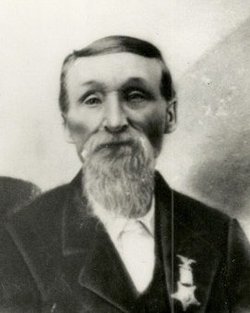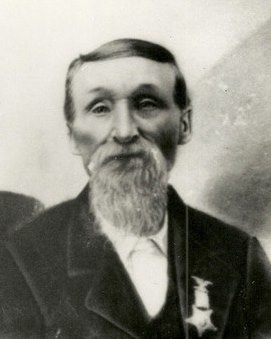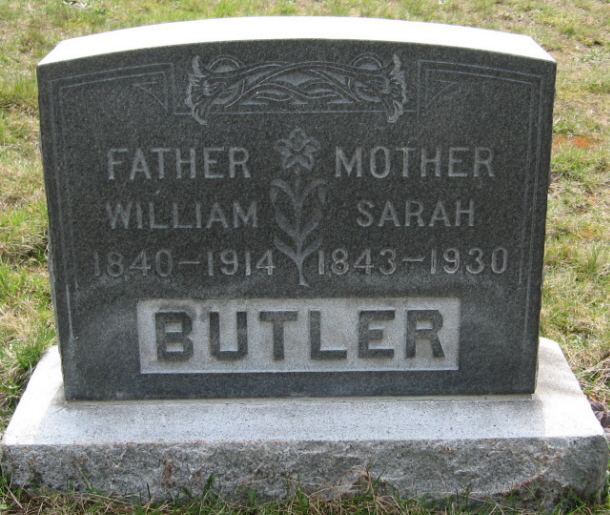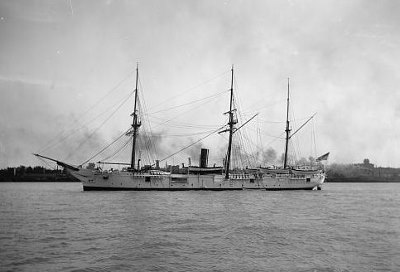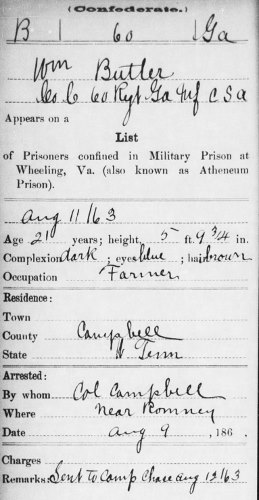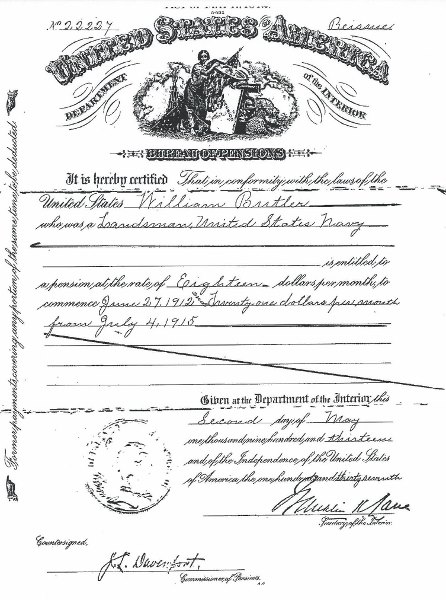Not long after the War, on February 21, 1867, William married Sarah Caroline Doak in Warren County, Iowa. All three of their children were born in Iowa: William Harvey born 1869, Mary Nancy born 1871 and Charles Andrew born 1873. Other states the family lived in were Nebraska and Missouri. The last census in which William was enumerated was the 1910 Washougal, Clark, Washington census.
In July 1914, when he was 74, William submitted an application for Admission to the Washington Veterans' Home in Retsil, Washington. It is in those papers that we learned that he was a Confederate prisoner at Camp Chase and that he had served in the Union Navy.
In order to complete the application, William needed evidence of military service. He did not have his discharge papers as he had submitted them years earlier in support of his Nebraska homestead claim. In lieu of discharge papers, the Veteran's Home received a letter from the Navy Department, Bureau of Navigation, Washington, D.C. which stated: "The Chief of Bureau directs me to state that William Butler, a confederate prisoner, enlisted in the navy June 11, 1864, and was discharged November 29, 1864."
His military file indicates that he served the CSA in Co. C, 60th Regiment Georgia Infantry. The 60th was active in the campaigns of the Army of Northern Virginia from the Seven Days' Battles to Cold Harbor (Confederate Victory), and then was involved in Early's Shenandoah Valley operations and the Appomattox Campaign (Union), Second Manassas (Confederate), Antietam (Indecisive), Fredericksburg (Confederate), Chancellorsville (Confederate), Second Winchester (Confederate) and Gettysburg (Confederate). Just weeks after the battle at Gettysburg, William was captured on August 11, 1863 in Romney, Pennsylvania, about 125 miles southwest of Gettysburg. He was taken to the military prison at Wheeling, Virginia (also known as Atheneum Prison) and transferred in December 1863 to Camp Chase Prison near Columbus, Ohio.
Toward the end of the war, both the South and North were offering the opportunity to prisoners to fight with their captors. This was because supplies, including food and clothing, were sparse for prisoners. Whatever supplies they had were needed by their respective troops. Thus, prisoners at Camp Chase were given the opportunity to enlist in the Union. Responses to questions regarding William's service in the Union Navy, i.e., company and regiment, where and when he was discharged, etc. are unreadable. What was clear in his documents was that William served as a landsman on the gunboat "Yantis." He served about 6 months until his discharge due to a "disability from measles." In William's application to the Veterans' Home in 1914, in addition to his immediate family, he included his brother, "Dock Butler" in Kingfisher, OK.
At the time of William's application to the Veterans' Home he had been suffering for six or seven years with arthritis deformans and was entirely helpless and confined to bed. Sarah wanted to go with William to the Veterans' Home so she could tend to his daily needs. A letter was written to the Home by William's doctor setting forth her wishes and recommending that she also be admitted so she could take care of him. William and Sarah were accepted in the Home. William died six months later on November 27, 1914. Note in the above picture that William, who had enlisted in the Confederate Army, was wearing his G.A.R. badge for service in the Union Navy.
(Bio by Janet )
Not long after the War, on February 21, 1867, William married Sarah Caroline Doak in Warren County, Iowa. All three of their children were born in Iowa: William Harvey born 1869, Mary Nancy born 1871 and Charles Andrew born 1873. Other states the family lived in were Nebraska and Missouri. The last census in which William was enumerated was the 1910 Washougal, Clark, Washington census.
In July 1914, when he was 74, William submitted an application for Admission to the Washington Veterans' Home in Retsil, Washington. It is in those papers that we learned that he was a Confederate prisoner at Camp Chase and that he had served in the Union Navy.
In order to complete the application, William needed evidence of military service. He did not have his discharge papers as he had submitted them years earlier in support of his Nebraska homestead claim. In lieu of discharge papers, the Veteran's Home received a letter from the Navy Department, Bureau of Navigation, Washington, D.C. which stated: "The Chief of Bureau directs me to state that William Butler, a confederate prisoner, enlisted in the navy June 11, 1864, and was discharged November 29, 1864."
His military file indicates that he served the CSA in Co. C, 60th Regiment Georgia Infantry. The 60th was active in the campaigns of the Army of Northern Virginia from the Seven Days' Battles to Cold Harbor (Confederate Victory), and then was involved in Early's Shenandoah Valley operations and the Appomattox Campaign (Union), Second Manassas (Confederate), Antietam (Indecisive), Fredericksburg (Confederate), Chancellorsville (Confederate), Second Winchester (Confederate) and Gettysburg (Confederate). Just weeks after the battle at Gettysburg, William was captured on August 11, 1863 in Romney, Pennsylvania, about 125 miles southwest of Gettysburg. He was taken to the military prison at Wheeling, Virginia (also known as Atheneum Prison) and transferred in December 1863 to Camp Chase Prison near Columbus, Ohio.
Toward the end of the war, both the South and North were offering the opportunity to prisoners to fight with their captors. This was because supplies, including food and clothing, were sparse for prisoners. Whatever supplies they had were needed by their respective troops. Thus, prisoners at Camp Chase were given the opportunity to enlist in the Union. Responses to questions regarding William's service in the Union Navy, i.e., company and regiment, where and when he was discharged, etc. are unreadable. What was clear in his documents was that William served as a landsman on the gunboat "Yantis." He served about 6 months until his discharge due to a "disability from measles." In William's application to the Veterans' Home in 1914, in addition to his immediate family, he included his brother, "Dock Butler" in Kingfisher, OK.
At the time of William's application to the Veterans' Home he had been suffering for six or seven years with arthritis deformans and was entirely helpless and confined to bed. Sarah wanted to go with William to the Veterans' Home so she could tend to his daily needs. A letter was written to the Home by William's doctor setting forth her wishes and recommending that she also be admitted so she could take care of him. William and Sarah were accepted in the Home. William died six months later on November 27, 1914. Note in the above picture that William, who had enlisted in the Confederate Army, was wearing his G.A.R. badge for service in the Union Navy.
(Bio by Janet )
Inscription
Father
